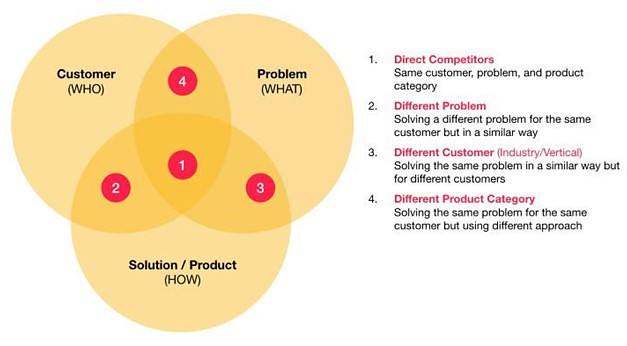What's the first thing that comes to mind when you think of a particular product type? If it's electric cars, you probably think of Tesla. Internet search engines? That'd be Google. Men's shaving products? That's got to be Gillette (or maybe Dollar Shave Club).
All those companies have one thing in common: successful branding. They've established themselves as market leaders in their respective sectors. There's a reason "google it" has become synonymous with searching online.
That level of recognition is the Holy Grail for any business, and brand-mapping can help you achieve it.
Using brand-mapping, you can differentiate yourself from the competition and keep your company in customers' minds.
Here are five steps to get there.
1. Identify your current market position
The first step is to consider your business in the broader context of the market. Ask yourself these questions:
- Is your product unique, or is it one of many options available?
- Are you offering your customers a new solution to an old problem?
Your market position has a big impact on brand recognition.
In a crowded marketplace, leaders dominate their field while competitors fight over what's left. If you operate in such a marketplace, you'll need to offer something that makes you stand out. In other words, your product must be faster, cheaper, or better than your competitors' offerings.
Companies with a unique offering in a new niche don't need to be better, faster, or cheaper. Those factors matter less because there is no alternative. You can establish your business as a market leader and set industry standards. Competitors will, however, slowly emerge to contest your position as the market leader and use strategic positioning to highlight differences.

Source: Myk Pono
Some great business resources explore the topic of market creation and positioning in greater depth. Blue Ocean Strategy is one such resource. Another interesting read is Play Bigger: How Rebels and Innovators Create New Categories and Dominate Markets.
2. Do a competitor analysis
You'll also need to understand the competition, so analyzing your rivals is a must. Once you understand their strengths and weaknesses, you can develop a strategy that's to your advantage.
You can use various methods to identify your rivals:
● Market research. Thanks to the Internet, this is relatively easy. Just head to your search engine of choice and enter a few relevant keywords, and you'll get information on competitors in your market.
● Customer surveys. Approach your current customers and ask them for feedback. What companies did they consider before settling on you?
● Social media. Most businesses use social media to engage with prospective customers and grow an engaged community. Search for a few businesses and review their sales and marketing strategies and the social channels they favor.
Once you've identified your competitors, you'll be able to assess them. What are their bestselling products? What marketing strategies do they use? What share of the market do they command? You can use such information to help with your brand positioning.
3. Determine your USP
Once you've identified the strengths and weaknesses of your competitors, you can make one of your strengths into a unique selling proposition (USP). That can be anything from cheaper products to a low average handle time.
In the SaaS space, Tableau is considered one of the market leaders in business intelligence and analytics, which is a crowded niche where almost all the tech giants such as IBM and Microsoft have established themselves as major players. However, Tableau is able to set itself apart from the competition because of its USP:

Source: Tableau
The first 16 words of Tableau's value statement say a lot about what it is: a platform that is easy to learn, helping its users make an impact on their respective businesses.
The rest of the value proposition expounds on the reasons Tableau has reached that status, which include its passionate user base and industry-leading security.
Your USP is the problem that only you can solve, so build your marketing strategy around it. It's worth dedicating a lot of time to.
Few businesses are one of a kind. Successfully pinpointing your USP will help you define your messaging. Consistent messaging that builds on your USP can help you connect with your audience.
4. Draft a positioning statement
Once your USP is identified, it's time to draft a positioning statement, which is ideally no more than two sentences long. The short statement defines the unique value you provide to your customers. The clearer it is, the better your audience and staff will understand why your brand is right for them.
Condensing all the information about your company into two lines is tricky, especially when the natural reaction is to talk passionately and at great length. To help, try asking yourself the following questions:
- Who are your customers?
- What is your product category?
- What benefits does your product provide?
- How can you prove that?
Use the answers to draft a brief, powerful statement. And once you've decided on it, you'll need to ensure your brand aligns with it. From email signatures to webpages, all aspects of the business must align with your positioning statement.
Writing the statement isn't enough to actually position your business, but it is integral to the strategic process.
5. Test your position with a brand map
Brand-mapping is a never-ending process. As long as your business remains in operation, you should continually analyze your success. Do customer surveys, check your bottom line, and assess your position to see whether it supports your business.
Brand-mapping is an excellent way to do that. "Perceptual brand mapping is the visual plotting of specific brands against axes, where each axis represents an attribute that is known to drive brand selection," states the American Marketing Association (AMA).
AMA also lists three benefits of brand-mapping:
- It unlocks insights about the industry and your competitors.
- It tells you the direction your brand is heading.
- It helps determine whether your brand aligns with your business strategy.
The Gartner Magic Quadrant is not often described as a perceptual brand map; but, in fact, it has all the elements of one. It shows you how brands are perceived by users and investors relative to their competitors.
Here is a Magic Quadrant for network security solutions.

Source: Elastic
Axes determinants are the keywords that define your brand and attract customers. So, the first part of brand-mapping is selecting the right ones and understanding why your customers value them.
In the previous case, the determinants are the ability to execute and the completeness of vision. Let's say the brand being considered is IBM. Gartner assigns it a score according to its perceived ability to execute and the completeness of its vision. Based on its location in the Magic Quadrant, it ranks high on both determinants and is considered a market leader in the security information and event management niche.
In contrast, IBM competitor Huawei is not able to execute its vision well and is also lacking in innovation and forward-thinking initiatives. Its scores make it a niche player in the industry, which means it has a lot more work to do before being considered a market-leading business.
You can use brand-mapping similarly to assess your business. It allows you to discover your marketing strategy's effectiveness and whether consumers recognize your USP.
Brand-mapping is also a great way to assess what other companies in your industry are doing, as well as assess market trends.
* * *
Brand-mapping is an effective tool for any business, but it's important to remember that it is never finished. The market continually evolves, so brand-mapping should be a regular part of your internal analysis. It helps you understand where you are compared with your competitors and recognize how your customers perceive you.
Once you know where you are and where you want to be, you can create a strategy to make it happen.
More Resources on Brand-Mapping and Positioning
Knowing How Your Competitors Are Positioned: The Key to Competitive Intelligence
Be Positioned or Get Positioned: Do's and Don'ts for Transforming the Perception of Your Brand




